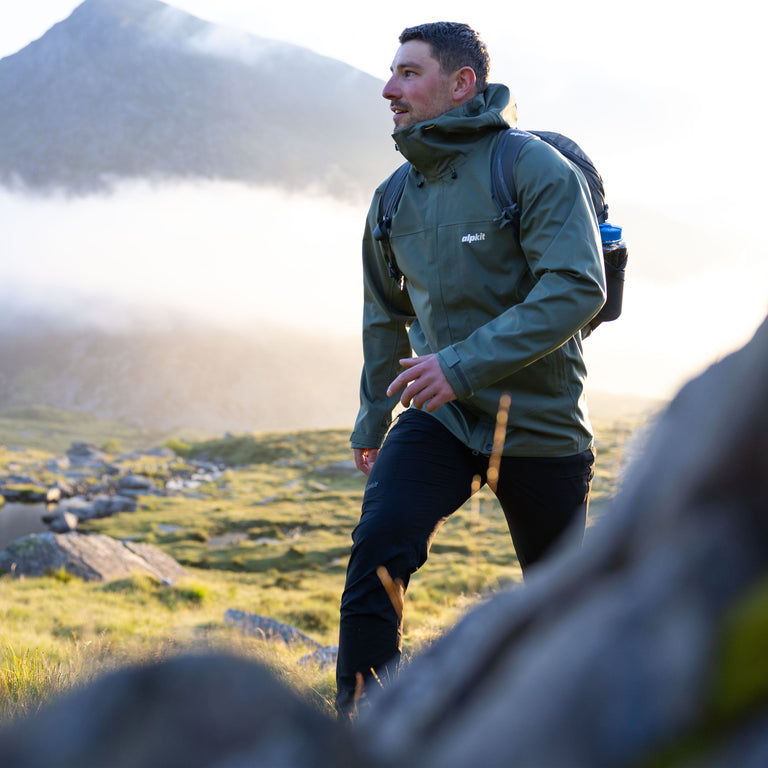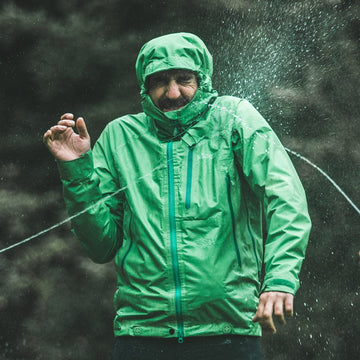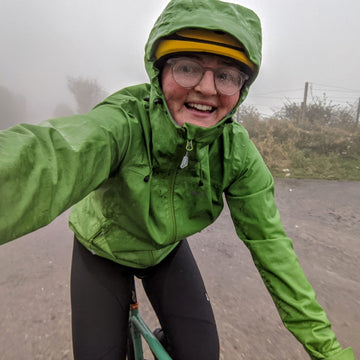
Learn how Ventile© fabric performs in extreme conditions. Discover its natural waterproofing and why it's used in serious outdoor gear.
Ventile® is a high-tech cotton fabric, woven in Switzerland from the highest quality cotton. Weatherproof, highly breathable and naturally hardwearing, it's kept RAF pilots alive in the icy Atlantic, crossed both poles and conquered the world's highest mountain.
Ventile® also, eventually, absorbs water. "Absorbs water?" you say, "What's the point in that? You should never wear cotton on the hill, you know." Normally we'd agree! But Ventile® is much cleverer than your standard cotton jacket fabric. If it's good enough for Edmund Hillary and Ranulph Fiennes, it's good enough for us!
What is Ventile® and how does it work?
- The development of cotton outdoor gear
- A history of Ventile®
- How does Ventile® work?
- Is Ventile® waterproof?
- Why is Ventile® so breathable?
- What makes Ventile® so hardwearing?

From Chorley to Everest – The History of Ventile®
Technical cotton clothing has a long history of use in the outdoors, worn by mountaineers, polar explorers and outdoor enthusiasts alike. In fact, cotton reigned supreme for nearly a hundred years until ripstop polyester and nylon came along.
Early polar explorers experimented with the fur clothing used by indigenous Inuit populations. But while fur was perfect for dog sledding, it was highly impractical for man-hauling sleds. Fur clothing was heavy and non-breathable, absorbing sweat which then froze solid. Requiring greater breathability, mountaineers adopted heavy woollen shooting jackets known as 'Norfolk jackets'. These were worn throughout the Golden Age of Alpinism, including on Edward Whymper’s ascent of the Matterhorn in 1865. However, by the turn of the century, a revolution in outdoor clothing was already beginning.

Burberry Gabardine 1879 - 1930s
In 1879 Thomas Burberry (whose company is now better known for its infamous beige tartan) patented a fabric called 'gabardine'. This cotton fabric had a dense twill weave and was treated with lanolin, the waxy substance sheep use to keep their wool dry in wet weather. Gabardine was windproof, water resistant and, crucially, breathable. It was also far lighter than heavy woollen equivalents.
This new fabric was used by Norwegian polar explorer Fridtjof Nansen on his expedition to reach the North Pole in 1893, by Ernest Shackleton on three separate expeditions, and by George Mallory and Sandy Irvine on their fateful 1924 Everest expedition. A research team from four UK universities recreated Mallory and Irvine's clothing from textile fragments and tested it on Everest in 2006. With two windproof garbadine layers, their state-of-the-art layering system was found to be highly effective at trapping insulating warm air and was deemed to be perfectly sufficient to have reached the summit.
Grenfell Cloth 1930s - 1941
In the 1930s, Burberry was overtaken by a new cotton fabric known as 'Grenfell cloth', developed for Arctic missionary Sir William Grenfell. Unlike gabardine, Grenfell cloth relied on the tightness of its weave to repel water. Woven in Burnley, Lancashire using high grade cotton and skilled weavers, it was so water repellent that it also repelled the dye! Grenfell cloth was very expensive and became highly dependent on military contracts. During the Second World War it ceased production entirely as Ministry of Defence funds were required elsewhere. But this paved the way for something else.



Ventile® 1941 - Today!
In 1941 Ventile® was perfected by the Shirley Institute (an informal name for the British Cotton Resarch Association) in Didsbury, Manchester with the aim of reducing the casualty rate of air force pilots. RAF airmen would have to launch from the decks of merchant ships when providing cover at sea. Not carrying enough fuel to make it back to land, they were forced to either ditch the plane or bail out – straight into the icy waters of the Atlantic. Most men died within minutes of exposure. Pilots needed a garment that was cool and breathable in the cockpit but that would still provide protection when wet.
The Shirley Institute's new fabric used high quality cotton tightly woven into a pattern which, unlike Grenfell cloth, kept out water completely when the yarns swelled. Ventile® immersion suits improved airmen's survival chances dramatically – from a just a few minutes to 20 minutes. This improvement made rescue a real possibility. As a result, 80% of anti-submarine pilots who fell into the sea survived, compared with a mere handful previously.

Mass production and a new home
Ventile® went into mass production on the huge wooden looms of Talbot Weaving in Chorley, near Manchester. With its outstanding levels of breathability, durability and weatherproofing, Ventile® soon became the outer layer fabric of choice for polar explorers and mountaineers. Ventile® was used by Sir Edmund Hillary on the first ascent of Mount of Everest in 1953 and by Sir Ranulph Fiennes when he crossed the Arctic as part of his Transglobe Expedition from 1979 - 1982. It was the first performance fabric used by mountain rescue teams in the UK and it's still the preferred option for some polar explorers today!
Sadly, Ventile® is no longer made in Greater Manchester. Because it's so naturally water repellent, Ventile® is very difficult to dye. When Ventile's British dying house closed down, the dying process was moved to Switzerland – until these dying houses closed down too. Now Ventile® is made entirely in Switzerland by Stotz & Co. with a higher quality and level of performance than ever.


How does Ventile® work?

What makes Ventile® windproof and water repellent?
Ventile® is made from extra-long staple cotton fibres, the highest quality of cotton available. Just 2% of the world's cotton production is extra-long staple. The quality of these fibres creates stronger yarns, allowing Ventile® to be made with an incredibly tight 'Oxford weave'. Because the weave is so tight, Ventile® is completely windproof. It also gives the fabric an incredibly high surface tension, causing rain droplets from passing showers to bead on the surface rather than instantly soaking in. In addition to this, the organic Ventile® we use is treated with a PFC-free durable water repellent (DWR).

Is Ventile® waterproof?
Because Ventile® absorbs water, it isn't strictly waterproof in the same way that waterproof jackets work?">fabrics with waterproof membranes are. It is possible to make fully waterproof Ventile® garments using two layers of fabric but this can make garments too heavy for active use – especially when wet. Whilst not fully waterproof, single-layer Ventile® provides significantly more rain protection than modern softshell fabrics – enough for all but the wettest of days. But if there's no membrane, how does it work?
In more prolonged rain, the cotton fibres on the outside of the fabric absorb water and swell. When the fibres swell, they close up microscopic gaps in the weave, stopping surface water from seeping through. The external fibres can't absorb any more water, forming an impenetrable rain barrier and keeping the inside drier for longer. It's a similar principal to old school tent canvas. This means Ventile® actually gets more protective the worse the weather gets, stiffening as the fibres swell so that it feels more like a waterproof jackets and women's waterproof jackets">waterproof hard shell.

Why is Ventile® so breathable?
One of the reasons cotton is outdoor clothing">so comfortable to wear as a material is because it's naturally breathable (it allows moisture to pass through it). Cotton fibres can absorb an incredible amount of moisture before they start to feel damp. Ventile® doesn't have a membrane either, allowing moisture from your body to pass easily through the microscopic holes in the weave. This means the fabric works with the other layers in your layering system, keeping you a comfortable temperature (and moisture level!) even when you're working up a sweat. This unrivalled breathability is one of the reasons it's still used by the British Antarctic Survey today.
What makes Ventile® so hard wearing?
Cotton fibres have a naturally high tear strength, but the level of tear strength does vary depending on the quality of the yarn. Ventile® uses extra-long staple cotton fibres to make the highest quality yarn, doubled up in thickness for an even higher tear strength. These high-quality yarns are tightly woven in an 'Oxford weave' which creates a uniform fabric with a smooth outer face. It's this smooth outer face that helps give Ventile® its super high levels of abrasion resistance. With no membrane to wear out over time, Ventile® can easily last a lifetime. Or several! Should you manage to tear it, it's easy to Repair station - Repair your outdoor kit">repair with a simple needle and thread. Any holes around the stitching will simply close up when the fabric gets damp.



Traditional technology, modern design
Our new Ranger jacket uses 100% organic cotton Ventile®, treated with a PFC-free DWR. We really wanted to provide a natural fibre alternative in our outer layer range so Ventile® was the obvious option. It's a truly technical fabric with a great history that perfectly suits the windy, drizzly, showery weather of Britain's mountains and upland areas. The Ranger combines Ventile's traditional technology with everything we've learnt about designing waterproofs for mountain environments. And we think it looks pretty smart too! You can find out more about the Ranger in our Q&A with Alpkit Design Manager, Ronnie.








![Gravitas [Mens]](http://us.alpkit.com/cdn/shop/files/mens-gravitas-2025-chilli.jpg?v=1765566103&width=768)
![Gravitas [Mens]](http://us.alpkit.com/cdn/shop/files/gravitas-location-1-RETOUCH.jpg?v=1765566103&width=768)
![Gravitas [Womens]](http://us.alpkit.com/cdn/shop/files/womens-gravitas-reef_2d13b155-8b33-426c-b830-bc1af1ad56df.jpg?v=1764270047&width=768)



![Fortitude [Womens]](http://us.alpkit.com/cdn/shop/files/fortitude-womens-2025-alder.jpg?v=1766603014&width=768)

![Balance [Mens]](http://us.alpkit.com/cdn/shop/files/balance-mens-2025-reef.jpg?v=1767293705&width=768)
![Balance [Mens]](http://us.alpkit.com/cdn/shop/files/Balance-mens-1.jpg?v=1767293705&width=768)
![Balance [Womens]](http://us.alpkit.com/cdn/shop/files/balance-womens-2025-black.jpg?v=1767293772&width=768)
![Balance [Womens]](http://us.alpkit.com/cdn/shop/files/Balance-womens-3.jpg?v=1767293772&width=768)

![Definition [Mens]](http://us.alpkit.com/cdn/shop/files/Definition-men-2.jpg?v=1764356982&width=768)

![Definition [Womens]](http://us.alpkit.com/cdn/shop/files/Definition-women-3.jpg?v=1764357034&width=768)




























